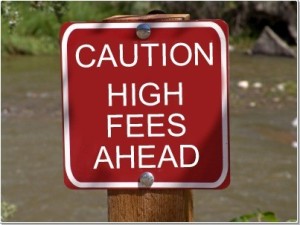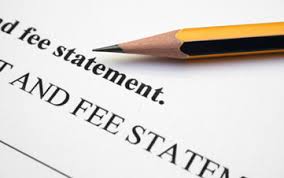How would you feel if you discovered that every time you put $10,000 into your retirement account, $4,000 or more of it ended up going to pay fees over the next 20 years? And another ten years later, nearly $8,000 of your initial investment had vanished into other people’s pockets?
I’m guessing you wouldn’t be a very happy camper. In fact, you’d probably be mad as heck.
I hate to be the bearer of bad news, but this is exactly what’s happening to most investors right now. Which means there’s a VERY good chance it’s happening to you.
You see, I’ve been burning the midnight oil researching the fees in popular mutual funds – including the ones in many 401(k) plans – for a new course in financial literacy we’ll be rolling out soon.
The course will give you a step-by-step plan for ending all your financial worries in as little as 90 days… and it contains breakthrough strategies you won’t find anywhere else. I’ll be giving you more details about it over the next month or two, so stay tuned.
But in the meantime, what I discovered about what experts have called “the silent enemy in our retirement accounts” – fees that compound against you that are charged by mutual funds and 401(k) and IRA plan administration costs – will stun you.
Let’s start with the cost of popular Target Date Funds or TDF’s,” the “default investment” in many 401(k) plans.
As I’ve written about before and discuss in detail in chapter 5 of my New York Times best seller, The Bank On Yourself Revolution, the mutual fund industry lobbied Congress to make TDF’s the default investment in 401(k)’s. And that became part of the law Congress passed called the Pension Protection Act of 2006.
These funds have some of the highest costs of all mutual funds, and their track records stink
But get this. If your employer follows the law and automatically puts your money into TDF’s, you have no recourse if you lose your shirt! Your employer has protection from liability.
 So, I researched the fees in the four largest/most popular Target Date 2030 mutual funds today. The year refers to the date you’re planning to retire, in this case 2030. These funds are supposed to invest more conservatively each year as you get closer to retirement.
So, I researched the fees in the four largest/most popular Target Date 2030 mutual funds today. The year refers to the date you’re planning to retire, in this case 2030. These funds are supposed to invest more conservatively each year as you get closer to retirement.
I said “supposed to,” because the Government Accounting Office found that during the crash of 2008, “some TDF’s designed for participants retiring in 2010 lost considerable value, just over 40% in one case.”
Can you imagine being just months from retirement, only to see your nest egg take a 40% hit? Would you be stunned? Devastated? “[M]any participants were unaware… that such losses were possible so close to the retirement date.” Ouch!
I found that three of the four largest Target Date 2030 funds have fees so high they will indeed devour nearly $4,000 of every $10,000 you put into them over the next twenty years. And that balloons to almost $8,000 over 30 years, due to the “negative compounding” effect of added-on mutual fund and plan administration fees. (But your employer can breathe a sign of relief.)
You see, compounding is a thing of beauty only when it’s working for you, as with compound interest.
Fees that are tacked on compound against you by an exponentially increasing amount over time. That means the longer you invest in these funds and plans, the bigger the bite they take out of your hard-earned savings.
And I found some Target Date 2030 funds with much higher fees than these – including one “brand name” fund that will devour 72% of your investment just over the first 20 years!
But what about “low cost” index funds?
That’s another area I’ve been researching – and there is no assurance that you will be paying low fees.
For example, the difference between three well-known funds that track the S&P 500 index is enormous, ranging from eating 5% or less of every $10,000 you put into them… to devouring 71% or more of your hard-earned dollars!
And none of these numbers even includes the rest of the plan administration and account fees you pay in a 401(k) or IRA!
A 2009 study by researchers from Harvard and Yale found that even well-educated savers …
overwhelmingly failed to minimize index fund fees. Instead, they placed heavy weight on irrelevant attributes such as funds’ annualized returns since inception.”
Which brings me to one of the biggest myths about Bank On Yourself…
Who complains the loudest that Bank On Yourself-type policies pay too much commission? Often stockbrokers and financial planners. They claim that high commissions are the only reason agents sell these policies.
Nope. The reality is that those whining money managers are actually making up to ten times as much off your business as Bank On Yourself Professionals! Let’s compare: Assume you put $10,000 per year for thirty years into a Bank On Yourself-type policy and the very same amount into an investment account.
According to those financial planners and experts, the agent who sold you the policy would earn about $10,000 commission in the first year and a small commission each year after that.
That would be true of the policies most representatives talk about. But because a Bank On Yourself Professional will direct much of your $10,000 annual premium into the riders that make your cash value grow a lot faster, that financial representative will only make between $3,000 and $5,000 in the first year, not $10,000. They’ll receive a small renewal commission during the remaining years, bringing the total commission paid over thirty years to about $8,500.
Meanwhile, the planner who’s complaining that this is way too much commission will earn a management fee every year of at least 1% of your account value (and often it’s 1.5% or even 2%) which, if the market has moderate returns over the same thirty years, means he’ll earn $100,000 – or more! You don’t need your calculator to figure who’s getting paid way too much.

Add to that, the investment account manager will not be able to tell you how much your account is going to grow over that thirty years because he has no clue. (Wanna try a fun experiment? Ask your broker or money manager if he’ll guarantee that you’ll have a specific amount in your account in ten or thirty years, and if he’ll give you a money-back guarantee if he misses the mark!)
On the other hand, before you even initiate a Bank On Yourself plan, you’ll know the minimum guaranteed value of your plan in any given year.
So let me ask you: Would you rather pay $100,000 to the money manager who has no idea how it will all turn out in the end? Or $8,500 to the Bank On Yourself Professional who can tell you your guaranteed result? By the way, unlike fees you pay a money manager, all fees and expenses, including the Bank On Yourself Professional’s commissions and the cost of insurance, have already been deducted from your guaranteed bottom-line numbers. There are no added-on fees to compound against you!
Would you like to find out what your guaranteed bottom-line numbers would be if you added Bank On Yourself to your financial plan? Just request your FREE Analysis here (if you haven’t already) and find out today!
REQUEST YOURFREE ANALYSIS!

Speak Your Mind